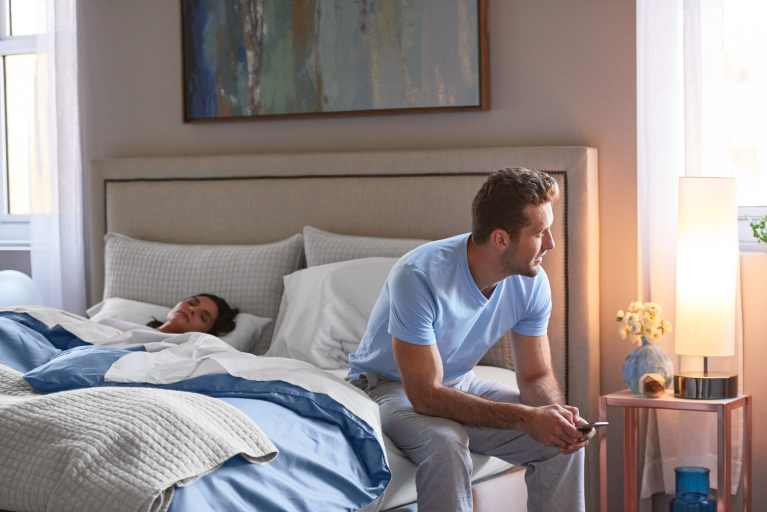
Half the morning at work is gone and you can't remember most of it. Did you answer those emails? Make the important phone calls on your list? Reschedule the sitter?
If you feel like you're on autopilot after being sleep deprived, you may suffer from local or micro sleep.
What is LoCAL SLEEP AND MICRO SLEEP?
Sleep deprivation appears to produce a phenomenon called local sleep, where parts of the brain actually doze off while you're awake. Micro sleeps are brief moments of sleep during wakefulness, lasting from a fraction of a second to 30 seconds, usually due to either sleep deprivation, sleep apnea or narcolepsy, says Robert Rosenberg, DO, FCCP, board certified sleep medicine physician and author of The Doctor's Guide to Sleep Solutions for Stress & Anxiety.
Researchers studied the electrical brain activity of sleep deprived rats. They discovered that problem solving sections of the rats' brains fell into a sleep-like state researchers dubbed “local sleep" while they were awake, as reported in the journal Nature.
According to neuroscientist and study author Giulio Tononi, you couldn't tell the rats were in a different state of wakefulness and despite periods of local sleep, their overall brain activity and functioning suggested they were awake. Scary, right? Researchers say the condition is likely seen in sleep-deprived humans too, though no studies have been done to date.
Until recently it was assumed that simple tiredness contributed to injuries and accidents, but scientists have found that parts of tired folks' brains actually do either fall asleep, as in micro sleep, or may switch off completely, as in local sleep, making people more likely to be casualties of slip-ups.
Why Would the Brain Turn Off When We Need It Most?
With micro sleeps there may be a constant struggle between the conscious and unconscious brain. Scientists studied what happens in the brain after sleep deprivation, during moments when people drop off, and published their findings in the journal Neuroimage.
Researchers kept 18 volunteers awake for 22 hours and then stuck them in a dark, warm fMRI (functional MRI) and told them not to go to sleep. When their eyes shut periodically in micro sleep, the scanner picked up reduced activity in the thalamus, the part of the brain responsible for relaying sensory and motor signals to other parts of the brain.
DO WE SLEEP LIKE BIRDS?
Researchers have made comparisons between local sleep and the needs of birds and marine mammals, which are known to take large regions of their brains “offline" instead of sleeping, to meet the needs of their lifestyle. Local sleep may be an adaptation of that.
OVERLOADING OUR NEORONS
The leading theory on local sleep hypothesizes that since neurons constantly record new information in the brain, at some point they need to turn off to reset themselves and prepare to learn new information. If they can't accomplish this during sleep because of severe sleep deprivation, they may have to switch off anyway while awake.
Tononi says if this hypothesis is correct, it means that putting off sleep will eventually overwhelm your neurons. Sleep deprivation could cause the neurons to reach their limit of how much input they can receive.
THE COST OF SLEEP DEPRIVATION
It isn't known how much sleep deprivation it takes to reach micro sleep or local sleep, although research shows that sleep deprivation can be devastating.
“Even before you feel fatigued, there are signs in the brain that you should stop certain activities that may require alertness," Dr. Chiara Cirelli, professor of psychiatry at the School of Medicine and Public Health, says in a press release. “Specific groups of neurons may be falling asleep, with negative consequences on performance."
These periods of micro sleep were thought to be the most likely cause of people falling asleep at the wheel while driving, Cirelli says. But the new research on local sleep has found that even before that stage brains are already showing sleep-like activity that impairs them when they are awake.
FAILURE TO RECOGNIZE
Since signs and symptoms can be subtle, it may be difficult to know if you or someone close to you is experiencing one of these sleep phenomenons. Physical indications of micro sleep include droopy eyes, slow eyelid closing and eye rolling, and head nodding.
People who experience a micro sleep usually feel like their mind has only momentarily wandered and typically can't tell they've been asleep, notes a report by the Texas Transportation Institute. They may even deny having fallen asleep.
HOW TO GET BETTER QUALITY SLEEP
You might avoid micro and local sleep episodes by getting sufficient sleep, addressing any existing sleep issues and taking breaks during monotonous tasks. If you believe that you are experiencing more serious signs of sleep deprivation, you should also discuss with your health practitioner.
Like diet and exercise, quality sleep is essential for optimal wellbeing and performance. Because everyone's sleep needs are different, Sleep Number® smart beds sense your movements and automatically adjust firmness, comfort and support to keep you both sleeping comfortably. Find your Sleep Number® setting for your best possible night's sleep.
*Based on average SleepIQ® data from 8/1/21 - 2/28/22 sleepers who engaged with their Sleep Number® setting, SleepIQ® data and FlexFit™ smart adjustable base received up to 170 hours more restful sleep per year